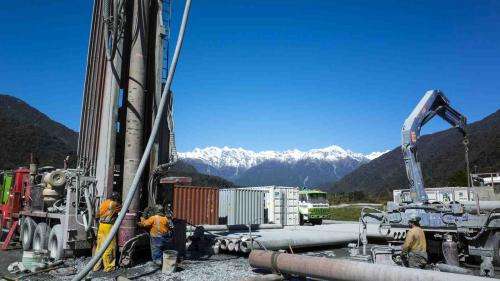Deep Alpine Fault borehole primed with instruments

An ambitious project to drill 1.3 kilometres into the Alpine Fault has been halted early by equipment problems, but it has still yielded a large amount of useful information about the inner workings of the fault.
Drilling stopped with the borehole at 893 metres. This is the deepest anyone has ever drilled into a fault in New Zealand, and was probably 100 to 200 metres short of the fault itself.
In spite of coming up short, the scientists involved in the Deep Fault Drilling Project at Whataroa, north of Franz Josef, are hailing the valuable information gleaned about the physical and chemical conditions inside the fault zone.
The project is being jointly led by Victoria University of Wellington, GNS Science and the University of Otago and is funded mainly by the International Continental Scientific Drilling Program, the Marsden Fund of the Royal Society of New Zealand, and the participating scientists' own organisations. It involves scientists from New Zealand organisations and from more than a dozen other countries.
The scientists discovered that temperatures increase by more than 140 degrees Celsius for every kilometre below ground.
Such a high rate of temperature increase has important implications for the way rocks behave and for understanding earthquake processes along the Alpine Fault and at other major faults worldwide.
And among the many rock samples recovered from the borehole, they found a large amount of graphite—a low-friction mineral that could have implications for the strength of the fault.
At much greater depth—six kilometres below the Southern Alps—earthquakes stop occurring because the rocks are so hot they become ductile, like the filling of a Moro bar, and bend and flow rather than fracture.
As the on-site phase of the project wraps up, the scientists are spending the next week or so installing equipment inside the borehole to measure a range of physical and chemical conditions. The borehole will become a permanent 'observatory' providing valuable information about conditions inside the largest and most dangerous fault in the South Island.
Dr Rupert Sutherland, of GNS Science and Victoria University, says the Whataroa Valley was a much more interesting and rewarding drilling site than they had imagined.
"The decision to stop drilling was made after steel casing inside the borehole was damaged part-way down and could not be repaired," says Dr Sutherland.
"A range of technical and safety concerns meant it was not feasible to continue drilling toward our target depth of 1.3 kilometres.
"However, we have learnt a vast amount about the structure and hydrology of the upper zone of the fault and about drilling in this challenging environment. Despite pulling up early in terms of depth, we are really happy with the technical and scientific achievements of the project.
"It is definitely feasible to reach all the way to the fault and we are keen to attempt this in the future. The very high rate of temperature increase with depth means that deeper drilling may enable us to sample rocks and fluids and document processes that usually happen at totally inaccessible depths."
Project co-leader Dr John Townend of Victoria University, says equipment installed in the borehole will allow ongoing measurements of conditions within the Alpine Fault.
"We have installed a fiber-optic cable extending the full length of the borehole that will enable us to make detailed temperature measurements on a repeated basis. The fiber can also be used to make seismic recordings as if we had dozens or even hundreds of seismometers strung out along the borehole. This is absolutely cutting-edge technology."
"A special seismometer has also been installed in the borehole 400m below the surface. We will incorporate it into the existing seismic monitoring network to record earthquakes deep within the Alpine Fault zone. When you're recording earthquakes, the deeper you can put your instruments, the better," says Dr Townend.
Provided by Victoria University
















